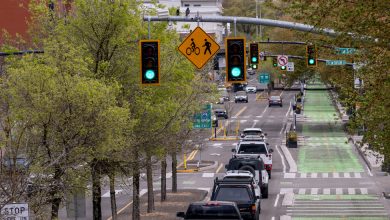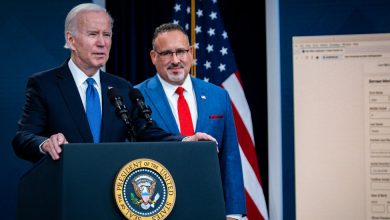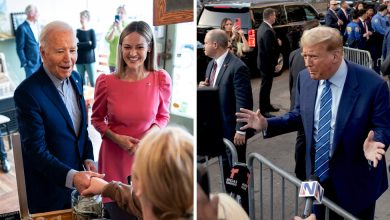What’s Dismaying Economists the Most About the New Inflation Figures

After Thursday’s report that consumer prices rose over the past year by the most since 1982, the Federal Reserve is under pressure to squelch inflation by raising interest rates. But if the Fed acts too aggressively, it could cause a recession and throw people out of work. And let’s face it, being unemployed is worse than paying more for stuff.
Stopping inflation without cutting the engine of the economy is extremely difficult and rarely successful. “In the past 60 years, not once did the economy manage to skirt a recession at this level of inflation,” David Rosenberg, chief economist and strategist of Rosenberg Research in Toronto, wrote in a client note on Thursday.
The Fed could reduce the risk of causing a recession by going slow on interest-rate hikes and counting on inflation to subside largely on its own. The two main factors that pushed inflation this high — 7.5 percent in the 12 months through January — are fading: Supply-chain bottlenecks are easing, and the fiscal stimulus that amped up consumers’ buying power is past its peak.
Professional investors, who have their own money on the line, are not worried about inflation over the long run, viewing the current spike as short-lived. A standard estimate of the average inflation rate over the next 10 years (as implied by the gap between ordinary and inflation-protected Treasury securities) is just 2.5 percent. In November, the median 10-year inflation forecast of professional forecasters surveyed by the Federal Reserve Bank of Philadelphia was 2.55 percent.
Granted, those investors and forecasters are assuming that the Fed will be vigilant against inflation, as it should be. But they’re also factoring in other forces that tend to keep inflation low, such as a recovery in the savings rate. Americans are saving somewhat more because the society is aging, which tends to reduce consumption and investment, as in Japan. At the same time, new technologies require less brick-and-mortar investment, which also tends to keep inflation low.
Inflation worry is a bipartisan affair. Ninety-five percent of Republicans, 88 percent of independents and 82 percent of Democrats said they were concerned about inflation in a December survey by The New York Times and Momentive, the online research firm formerly known as SurveyMonkey. “No other topic I write about generates as much hate mail,” my Opinion colleague Paul Krugman, a frequent critic of inflation worries, wrote in December.
Inflation at this level is also a new experience for many Americans. The median age of the U.S. population is 38.1, so half the country wasn’t even alive in 1982. They can find themselves panicked about inflation, too.
So it’s important to keep the damage from inflation in perspective. While no fun, today’s above-target inflation is in part a result of the emergency policies that quickly ended the pandemic recession of 2020. Sure, inflation was much lower a decade ago in the aftermath of the recession of 2007 to 2009, but the jobs recovery was painfully slow. The government’s performance this time is “worlds, worlds, worlds better,” Brad DeLong, an economist at the University of California, Berkeley, wrote in a blog post on Wednesday.
The chart below shows what has happened to workers’ pay over the past two decades after taking inflation into account. (I used the Employment Cost Index for total compensation because it includes benefits. It also isn’t thrown off by changes in the composition of the work force, the way some other metrics are. For example, average hourly earnings rose sharply in the spring of 2020 — but that was because the people who lost their jobs in the first phase of the pandemic tended to have lower pay.)
The chart shows that the current burst of inflation has indeed cut the inflation-adjusted — or “real” — pay of the average worker. But it also shows some big declines in periods when inflation was much lower, such as 2010 to 2012. “Inflation is not the only thing that matters for changes in real wages,” Juan Sánchez, an economist and vice president at the Federal Reserve Bank of St. Louis, told me.
An unexpected burst of inflation like the one we’re currently experiencing benefits debtors, at least in the short term, because their interest payments are fixed, while their pay tends to rise in line with prices. Homeowners tend to do well when inflation rises. Inflation is neutral for Social Security recipients because those payments are automatically adjusted for inflation. Unexpected inflation is a clear negative for people who earn a lot of income from bonds. That group tends to be well above average in income, but does include some people who are just getting by.
To economists, the worst thing about inflation is not the high prices, but the uncertainty. “The higher the rate, the more variable it is likely to be,” the economist Milton Friedman said in his 1976 Nobel lecture. Businesses are more reluctant to borrow, and banks to lend to them, when neither party knows what will happen to prices. Unfortunately, fighting inflation with aggressive monetary policy can increase, not decrease, uncertainty about the economic outlook.
Jerome Powell, the Federal Reserve chair, is aware of the risk of inadvertently triggering a recession. He has argued that keeping a lid on inflation prevents it from getting so high that extreme measures are required to stop it. As he knows, the longer today’s high inflation lasts, the greater the risk that people will start to think of it as the new normal.
What dismayed economists about the January inflation figure was not just the big price change from a year earlier, but the bigger-than-expected change from December. In the previous two months there were signs that monthly price increases were decelerating. “I was kind of hoping in January it would continue on its decline,” said David Andolfatto, an economist and senior vice president at the St. Louis Fed. “Instead it ticked up a bit.”
But Andolfatto said he’s still confident that inflation will trend down in the coming months. How far down, he said, will depend on how much companies are able to pass along higher costs to consumers, how much buying power consumers have, what happens to fiscal policy and whether cheap imports return to holding down goods prices, among other factors.
What happens with inflation will also depend on whether workers manage to win higher pay to make up for ground lost to inflation, Elise Gould, a senior economist at the Economic Policy Institute, told me. Low unemployment puts workers in a stronger position but isn’t enough, she said. To extract higher pay from their employers they also need a higher minimum wage, protections for organizing labor unions and stronger on-the-job protections, she said.
Would higher pay squeeze business profits and possibly spill over into prices? It might, Gould said, but she added: “That’s not much of a concern for me. We’re talking about low- and moderate-wage workers. We’re just trying to make sure that they can have a decent standard of living. That’s the first order.”
The readers write
Regarding your newsletter on Feb. 4: As a former director of substance addiction treatment programs, I’m very glad that you wrote about sports gambling addiction. The only difference between gambling and ingested substance addiction is that gambling is not ingested. The more frequently the pleasure centers are activated, the more quickly a person can become addicted. The old measures used by Alcoholics Anonymous and psychiatrists apply: Is it interfering with your life? Are your loved ones concerned? Does it affect your work?
Barbara Sloan
Conway, S.C.
Quote of the day
“The impulse to acquisition, pursuit of gain, of money, of the greatest possible amount of money, has in itself nothing to do with capitalism. This impulse exists and has existed among waiters, physicians, coachmen, artists, prostitutes, dishonest officials, soldiers, nobles, crusaders, gamblers, and beggars.”
— Max Weber, “The Protestant Ethic and the Spirit of Capitalism” (1930)
Have feedback? Send a note to [email protected].




